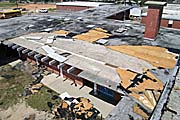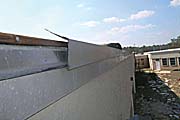The intense rebuilding that follows a hurricane means all aspects of a roofing contractor's daily business speed up enormously, while employees are dealing with their own personal trauma and basic items like gas, phones and electricity become luxuries. Recovery can take a year and temper reroofing for years to come. The old saying goes that roofing is best done when the sun is shining, but in the aftermath of a storm it takes planning to make sure the company doesn't get burned.
"Just imagine every existing customer you have needs something," says Greg Wallick, president of Best Roofing in Pompano Beach, Fla. "It's one of those situations where you've got tons of opportunities thrown at you. You're building versus just in an out."
Renewing New Orleans
Zachary Ellis is back in business after Hurricane Katrina. His New Orleans roofing contractor firm, The Ellis Co. LLC, founded in 1974, has materials and his shop survived the storm. He lost phone service for two and a half weeks, but more importantly a third of his trained workforce is gone because they lost their houses."I have 23 absent employees. I don't know when they'll be back," says Ellis, whose own house is unlivable. "It's tough to operate without them." Housing is a major problem that's holding up the recovery effort in New Orleans and elsewhere in the Gulf Coast. In an age where leaving a cell phone behind is disconcerting, losing a house can unnerve the most secure among us. The devastation in New Orleans was so extensive that everyone is scrambling for some kind of dwelling for residents and employees. It may take years for some areas to achieve the kind of mix that sustains a community, when electricity and comfortable surroundings are once again the status quo.
Ellis spent the first several weeks doing nothing but emergency repairs and is now scheduling those buildings for permanent roofs. Existing customers were addressed first, as well as public facilities performing critical functions. He does strictly commercial work and can't even guess how many hundreds of estimates he has pending as the phone continues to ring all day long, three months after Katrina struck. As the school boards are hiring consultants and drawing up plans, the private sector is streamlining the repair process.
"As soon as the insurance comes they say, ‘OK, we can go," Ellis comments. "It's getting off to a running start. We have more work than we can handle."

Rebuilding in Florida
Material shortages are becoming a serious problem in Florida, pitting storm repair against a surging population. As central and north Florida finalize repairs from 2004, the southern counties of Collier, Palm Beach, Broward and Dade are slammed for the next nine months to a year. Many roofing contractors are planning to double and triple the size of their workforce just to keep up, until the repairs are done and the next area beckons."That's pretty much the ebb and flow of the roofing industry," says Steve Munnell, executive director of the Florida Roofing and Sheet Metal Contractors Association (FRSA). As companies downsize after the frenzy or slow down for the winter, plenty of work awaits in the South. "The good news is workers can certainly be absorbed by other areas. There are a lot of contractors ... that are capable of sending crews."
FRSA has set up an informal referral system for its members, mainly through the phone. An attempt at a member's only message board on the association Web site is still awaiting enough contractors to get back online. Construction costs are getting more manageable. Gas is cheaper than it was at its peak last summer, and workers' compensation rates were lowered again this year: $35.40 per $100 in payroll, versus a high of over $54.00. Materials like asphalt shingles are becoming plentiful again, but the real holdup to recovery is the scarcity of concrete tile.
The ubiquitous Florida roof is so popular that many gated communities will allow only curved tile. Production builders are cranking out homes for the thousands of families that move to Florida each year, but now they must wait a year for delivery. Two of the state's six plants were off line after power outages from Hurricane Wilma, making the situation even worse.
"Concrete tile is a disaster," admits Munnell. "There's just no way they can keep up with the demand last year, plus this year. We just don't have the capacity to produce here. You're going to see people opt for metal and the super heavyweight shingles."
The curb appeal of other roofs may encourage homeowners' associations to relax their requirements, according to Munnell. There's at least one contractor in South Florida that installs nothing but stone-coated metal tile, more expensive than concrete but durable and available.

The Stone Age
The Sunshine State almost made it through the 2005 hurricane season when Hurricane Wilma gathered strength in the Gulf of Mexico and made her way through the southern tip of Florida. The tiny fishing villages of Everglades City and Chokoloskee on the west coast received extensive damage, while the newer buildings on exclusive Marco Island to the north mainly lost roofs and screen enclosures. The warm waters of the Everglades kept Wilma at a Category 4 and caught millions of people in southeast Florida off guard, including Wallick.I've boarded up my house time and time again," he explains. "I was convinced this was just another tropical storm. This one snuck up on us." He ended up not boarding his house and lost the roof, as did other employees, and his company was without a phone for three days and without power for 10 days. Still, he made plans for the coming damage, stocking up on materials so he was ready to roll as soon as the winds died down and the streets were clear. He also made a list of his existing customers and began calling them about assessing their damage.
"We had a tough time getting in touch with people," he says. "Everyone we talked to we did something for."
Drying in a flat roof takes some engineering, so he took whatever materials were available to cover gaping holes where rooftop equipment had once been. Best Roofing doesn't normally install single plies, but the company deployed large sheets of EPDM as a temporary measure. The company also found peel and stick membranes were effective; Wallick has used this technique in the past. He has been roofing in Florida for 28 years, and he started keeping a journal about what he has learned from past storms. One commodity that hadn't been a problem in the past posed a serious threat this year.
"Gasoline. Everything virtually came to a stop," he says. "Fuel was the most limiting resource."
Shortly after Hurricane Katrina damaged drilling and refinery operations in the Gulf, there were price spikes and shortages around the country. When hurricane preparation calls for having gas for cars and generators, the problem is only worsened in the areas most affected. It got so critical that Wallick detached a 500-gallon tank at his business, put in on a dump truck, and sent his driver north in search of gas. He would make daily trips to several service stations because no one would let him purchase a large quantity of this precious fuel.
Despite the hardship, Best Roofing did not miss a day of work and spent the first few weeks following the storm doing emergency repair work. Wallick has become such a veteran of this kind of work that he divides the recovery process in three phases: (1) emergency repairs, (2) bidding and permits for permanent reroofing, and (3) negotiating with building owners and insurance adjusters. That final phase has made Wallick cautious about putting repair work before paperwork, and he refuses to rush jobs because people are desperate. Past experience has shown that no matter what the circumstances, building owners won't tolerate leaks.
"Water coming in and water staying out, it's black or white," he says. "You don't want to overcommit. At the end of the day, nobody can afford to have a bad job."

Damage Control
Building codes have their origins in tragedy, and Florida's stormy past has fostered some of the most stringent codes for wind resistance. Roofs, windows, walls and outside equipment all have requirements that go beyond the International Building Code, but they must work in unison to be effective. A survey of damage in following Hurricanes Charley and Ivan in 2004 found that membranes that were properly installed can fall victim to air conditioning units that fly loose and tumble across the roof."When you get debris flying like that, there's not much to stop it," says David Roodvoets, technical director of the Single Ply Roofing Institute. "The roofing industry has little to do with it."
Roodvoets and several other industry professionals surveyed parts of Southwest Florida on behalf of the Roofing Industry Committee on Weather Issues. Their report is to be released soon, but Roofing Contractor got an exclusive look at some of the findings. The damage caused by the debris stream was significant and could turn well-performing roofs into failures. Some damage to single plies could be repaired with patches, but gaping holes left by rooftop equipment often meant a complete replacement. Roodvoets mentioned a condominium that fared rather well during Hurricane Charley - except for losing compressors from the roof that left 4-foot by 8-foot holes. As of press time, they hoped to be open by Christmas.
Maintenance was an issue identified by the team that could have prevented some of the damage, but workmanship was determined to be the contributing factor to most of the roof failures examined. In particular, the team found that a secure perimeter made a significant difference.
"Once the edge goes and the thing becomes a sail, you've lost your roof," says Roodvoets.
Untreated wood and improper fasteners were no match for the coastal environment. When in doubt, SPRI recommends stainless steel fasteners, according to Roodvoets. And even though not all the data on borate-treated wood is in, it appears to be a less corrosive and more resistant to rot than current alternatives. Florida codes recently adopted perimeter requirements developed in part by SPRI, but Roodvoets doesn't think the shouting is over just yet.
"We're looking at some real damage in the future, and it won't take a Hurricane Charley to reveal it," he warns.
Report Abusive Comment